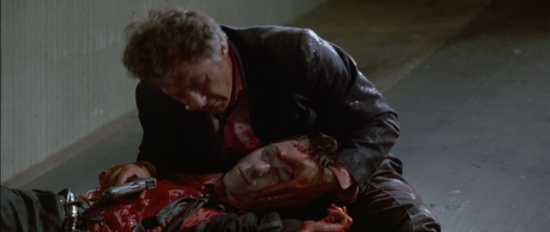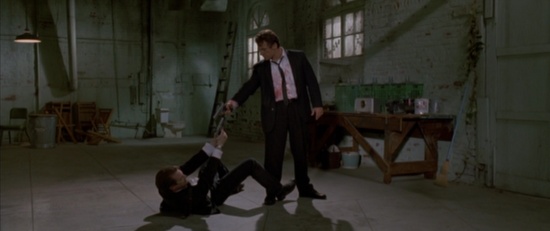Reservoir Dogs (Quentin Tarantino, 1992)

The problem with reviewing Reservoir Dogs is that right from its release in 1992, even its detractors generally agreed what its merits were: to review it risks simply listing them. Tarantino, in his first film, had shown he had a good eye for direction, and that he could write slick dialogue that was heavily laden with pop-culture references. He was capable with actors, or at least had a good eye for casting, with the ensemble he assembled here somehow already having the feel of a repertory company (looking back, what is surprising is how few of these actors he actually went on to use in his subsequent movies). And everyone agreed he had a talent for narrative: scrambling chronologies with confidence, he had crafted a taut thriller on a low budget. This is not to say that everyone loved or even liked the film, but rather that its detractors – many of whom remain vocal over a decade later – tended to react not to Tarantino’s technical skills, but rather to the personality that they perceived the film as embodying.
Even its champions tended, on its first release, to categorise Reservoir Dogs as a 90s update of the urban, violent, ultra-masculine crime thrillers produced by the “movie-brat” generation of directors (films such as Coppola’s Godfather series, Scorsese’s Taxi Driver, GoodFellas, and Casino, or Brian De Palma’s Scarface). The film’s critics painted Tarantino as the first of a depressing new breed: if Coppola, Scorsese, and De Palma were the film-school generation, Tarantino seemed to herald a new wave of less innovative imitators, educated only by watching their work on video. Tarantino’s goofy film-geek demeanour in interviews didn’t help to dispel the notion that he was a less serious-minded knock-off of those directors, reproducing the machismo toughness of their films without grasping their moral message. Certainly while I admired the film at the time, I had trouble discerning any real point to it, except the message “crime is bad,” which ultimately is notionally present in almost any crime movie (and doesn’t necessarily stop the films glorifying crime and violence along the way).
With the benefit of having seen two more of Tarantino’s films (I write this just prior to the release of his fourth film, Kill Bill), the message is clearer. Tarantino is not simply reproducing the type of film those directors made: he is showing us the type of people who modelled themselves on those films. When his camera circles the table at the start of the film, as these guys talk and joke and generally look macho, he seems to be setting up a group of men to rival the tough guys played by actors such as Al Pacino and Robert De Niro in the movie brats’ films (the casting of Scorsese regular Harvey Keitel strengthens the impression). Yet as much as these men project the typical movie image of professional, ruthless, cool killers, as the film progresses we see what they really are underneath: variously treacherous, psychotic, cowardly, or incompetent. Tarantino shows us that the ultra-cool movie tough guy is an act that they wear, much like the black suits that are their uniform. Pop-culture saturates the conversations because it is from television and the movies that these guys have lifted their criminal personae. It is said that The Godfather was a favourite amongst real mafioso, who liked its portrayal of their own lifestyle. Reservoir Dogs shows us criminals in this act of identification, playing to their own view of themselves as movie-style crims.
Look, for example, at the office of Joe, the mastermind of this criminal operation. With its big desk and sombre wood furnishings it instantly recalls the office of Don Corleone in The Godfather (on Mr Blonde’s introduction, Tarantino gives us a long, loving shot from outside the door that apes the famous closing shot of Coppola’s film). You can imagine why a criminal would love the mystique that Coppola constructed around that office: it was the domain of the untouchable crime boss, with vast powers, respected and feared by all. Joe has even followed the Corleones’ example and appointed his son as his chief lieutenant. Yet Tarantino quickly breaks down the imagery and shows the gulf between Joe (even the name seems low rent) and Vito Corleone. Vito could reign in Sonny with one quiet sentence, but Joe’s son Eddie wrestles with Mr Blonde and half destroys his office while Joe protests fruitlessly. Later, Mr Blonde and Eddie engage in a discussion about prison rape that is both homophobic and racist: Tarantino has been accused of being both, but it is clearly not meant as funny dialogue. Rather, it is the dialogue of men who think they are being funny and cool, but aren’t. It couldn’t be further from the measured deliberations of Coppola’s career criminals.
That the professional veneer of these men is an act that is learned is rammed home in the long sequence showing Mr Orange, the undercover cop, rehearsing his part. Coached by another undercover officer, he rehearses his stock funny story over and over. Tarantino progresses the story through the rehearsals until eventually the dialogue is being played in front of Eddie and Joe, interchangeable with any of the other long, joke-like monologues that the characters deliver in front of each other. (Tarantino even shows us the events Orange’s story is describing, demonstrating the interchangeability of the fiction Orange is spinning and the fiction Tarantino himself peddles). This long, otherwise pointless scene is critical because it shows the way that the personalities of the “cool” criminals we see in the film are built on talk. This story, and the ability it brings to mock-casually brag about his criminal experience, is the means by which Mr Orange will ensure acceptance in this gang’s world. Later, when he sits sullenly in the back of the car, excluded from the conversation, it is when he can chime in with a pop-culture reference (knowledge of Pam Grier’s filmography) that he starts to fit in. It is the cultural landscape of music, movies, and television – rather than criminal experience, or the family or ethnic background shared by Coppola’s criminals – that these guys share and get their role-models from.

That this perhaps isn’t quite the basis on which to construct the skills and trust needed to perform a robbery becomes abundantly clear as things progress. The “dogs” are obviously not the tough, super cool guys their slow motion swagger over the opening titles suggests. The title Reservoir Dogs, revealed over that sequence (and which in interviews Tarantino disingenuously suggests was meaningless) is very evocative of what they are: underfed vermin living in the margins and fighting over scraps. Certainly when the robbery goes bad they quickly turn on each other. The Corleone family, when there were traitors in their midst, could carry out the necessary executions with clinical precision. By contrast, Joe’s gang completely annihilates itself (only Blue, Brown and perhaps Pink die at the hands of people outside the group). Even the paternal Mr White, after Orange the character the audience most trusts, is gradually exposed as a foolish, brutal maniac. The similarity of the names White and Blonde, and their parallel relationships to Joe, demonstrate how closely aligned the superficially honourable White is with the more overtly psychotic Blonde. White obviously thinks of himself as calmer and saner, but he constantly pushes other characters to the edge of having to shoot him. The film’s repeated motif of the handgun stand-offs (between White and Pink, and then finally the fatal confrontation between White, Joe and Eddie) shows just how the ego and testosterone-driven personalities of these men lead to their downfall. Mr Pink likes to insist he is acting as a professional, but in fact nobody in the gang is.
Pink is last seen fleeing the warehouse after all the others are dead, victims of their own incompetence (the soundtrack suggests he dies too). Those who like to portray Tarantino as a childish filmmaker should look at how astutely he depicts and reveals the shallowness of these characters. There is substance behind the razzle-dazzle.